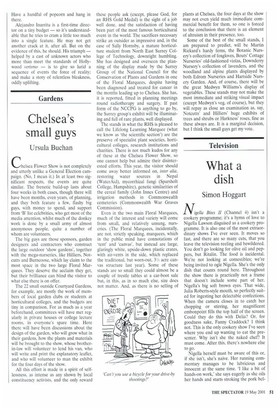Gardens
Chelsea's small guys
Ursula Buchan
Chelsea Flower Show is not completely and utterly unlike a General Election campaign. (No, I mean it.) In at least two significant respects, the events are quite similar. The frenetic build-up lasts about four weeks in both cases, though there will have been months, even years, of planning, and they both feature a few, flashy big guys, with money to spend, and support from `B' list celebrities, who get most of the media attention, whilst much of the donkey work is done by a small army of almost anonymous people, quite a number of whom are volunteers.
The big guys are those sponsors, garden designers and contractors who construct the large outdoor 'show gardens', together with the mega-nurseries, like Hilliers, Notcutts and Burncoose, which lay claim to the most space in the two large Floral Marquees. They deserve the acclaim they get, but their brilliance can blind the visitor to what else there is on offer.
The 22 small outside Courtyard Gardens, for example, are mostly the work of members of local garden clubs or students at horticultural colleges, and the budgets are tiny in comparison. For as much as a year beforehand, committees will have met regularly in private houses or college lecture rooms, in everyone's spare time. Here there will have been discussions about the design of the garden, who will grow what in their gardens, how the plants and materials will be brought to the show, whose brotherin-law will volunteer to lend his van, who will write and print the explanatory leaflet, and who will volunteer to man the exhibit for the four days of the show.
All this effort is made in a spirit of selflessness, as intense as any shown by local constituency activists, and the only reward these people ask (except, please God, for an RHS Gold Medal) is the sight of a job well done, and the satisfaction of having been part of the most famous horticultural event in the world. The sacrifices necessary strike an outsider as impressive and, in the case of Sally Hornsby, a mature horticulture student from North East Surrey College of Technology, downright humbling. She has designed and overseen the planning of the display made by the Surrey Group of the National Council for the Conservation of Plants and Gardens in one of the Floral Marquees, despite having been diagnosed and treated for cancer in the months leading up to Chelsea. She has, it is reported, fitted in planning meetings round radiotherapy and surgery. If past form of the NCCPG is anything to go by, the Surrey group's exhibit will be illuminating and full of rare plants, well displayed.
The stands in what the RHS is pleased to call the Lifelong Learning Marquee (what we know as 'the scientific section') are the preserve of specialist plant societies, horticultural colleges, research institutions and charities. There is not much kudos for any of these at the Chelsea Flower Show, so one cannot help but admire their disinterested efforts. This year, the visitor should come away better informed on, inter dila, restoring water sources in Nepal (WaterAid), mycorrhizal fungi (Sparsholt College, Hampshire), genetic similarities of the cereal family (John Innes Centre) and irrigation methods in Commonwealth cemeteries (Commonwealth War Graves Commission).
Even in the two main Floral Marquees, much of the interest and variety will come from small, and relatively unsung, nurseries. (The Floral Marquees, incidentally, are not, strictly speaking, marquees, which in the public mind have connotations of 'tent' and 'canvas', but instead are large, glaringly white, upside-down plastic crates, with air-vents in the side, which replaced the traditional, but worn-out, 3'12 acre canvas structure last year). Some of these stands are so small they could almost be a couple of trestle tables at a car-boot sale but, in this, as in so much else, size does not matter. And, as there is no selling of plants at Chelsea, the four days at the show may not even yield much immediate commercial benefit for them, so one is forced to the conclusion that there is an element of altruism in their presence, too.
Some of the best of the small stands, I am prepared to predict, will be Martin Rickard's hardy ferns, the Botanic Nursery's collection of foxgloves, Bouts' Cottage Nurseries' old-fashioned violas, Downderry Nursery's collection of lavenders, and the woodland and alpine plants displayed by both Edrom Nurseries and Hartside Nursery Garden. And, of course, there will be the great Medwyn Williams's display of vegetables. These stands may not make the most immediate and striking visual impact (except Medwyn's veg, of course), but they will repay as close an examination as, say, Notcutts' and Hilliers' huge exhibits of trees and shrubs or Harkness' roses, fine as these always are. It is a marginal decision, but I think the small guys get my vote.


































































 Previous page
Previous page